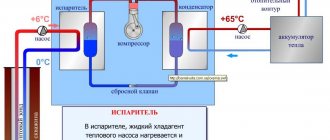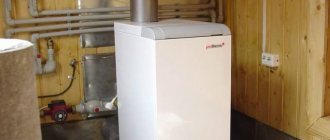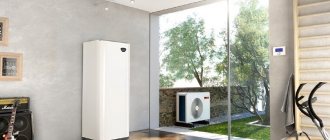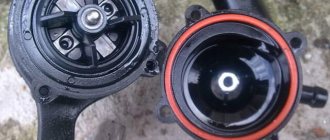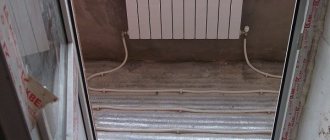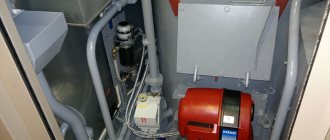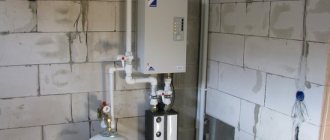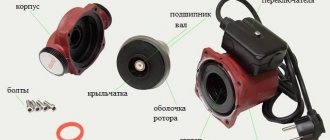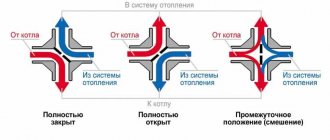Main characteristics of circulation pumps
The main characteristics by which the choice of circulation pump is made:
- pressure
, showing the ability of the device to raise water to a certain height; - performance and flow
, showing how much fluid the supercharger delivers per unit time.
These parameters are key in calculating the heating system. The pressure will allow you to understand whether the blower is capable of serving a pipeline network with a certain height difference. And the flow rate is calculated according to the requirements of the heating boiler for the planned volume of coolant.
All the data the user needs is contained in the markings on the front panel
. The numbers on the circulation pump mean:
- type of device (most often it is UP - circulation);
- speed control type (not specified - single-speed, S - step switching, E - smooth frequency control);
- diameter of the pipes (indicated in millimeters, means the internal dimension of the pipe);
- pressure in decimeters or meters (may differ among different manufacturers);
- installation dimensions.
The pump marking also contains information about the types of connections of the inlet and outlet pipes. The complete coding scheme and word order looks like this:
Responsible manufacturers always follow standard labeling rules. However, individual companies may not indicate some of the data, for example, installation dimensions. You need to find it out directly from the documentation for the device.
The choice of a circulation pump is always made after a careful calculation, which takes into account the type of heating equipment, the volume of coolant, elevation differences, and the minimum required blower performance.
Advice! You cannot buy products from unknown companies that copy products from reliable and popular brands. Such a pump is an ineffective investment. The use of low-quality materials, impellers, and turbines with limited service life leads to rapid failure of the supercharger. On specialized forums you can find many scary stories in photographs about the kind of technological nihilism that the housings of Chinese “no-name” products contain.
Therefore, you should choose a pump only from trusted brands. Reliable devices are also available in the mid-price category
And if you need the highest quality and have the opportunity to pay one and a half to two times more, you should pay attention to products from the brands GRUNDOFS, WILO
Installation of the pump: stages and nuances during installation
The first thing to do is drain all the liquid from the heating system. Then, if necessary, the pipeline must be cleaned. In accordance with the connection diagram, work on installing equipment and fittings must be carried out. When the installation of the heating system is completed, fill the water. after which excess air is removed from the pump. This is done by opening the central screw
Please note that before each time the unit is turned on, it is necessary to carry out air removal work
When a circulation pump for heating is purchased, you need to decide on the place where it will be installed. Experts recommend installing this equipment on the return line in front of the boiler. The thing is that air can collect at the top of the boiler during operation if the pump is installed on the supply side. This may cause it to be drawn out of the boiler, causing a vacuum to form, causing that part of the boiler to boil.
If the pump is installed in front of the boiler, then water will be pushed into the heating installation. The consequence of this will be the creation of air space and the installation will be completely full. In addition, with this installation option, the pump will operate at lower temperatures, which will have a positive effect on its service life.
Having selected the installation site for pumping equipment, then create a bypass or outlet. The need for it is due to the fact that in the event of a breakdown or when the electricity is turned off, thanks to it, the operation of the entire heating system will not stop and there will be an opportunity for the coolant to pass through the main pipeline thanks to an open tap. When installing a bypass, it is necessary to remember that the diameter of the pipe should be smaller than the diameter of the main pipeline. When the bypass is ready, proceed to the main stage of work on installing the unit.
The heating pump shaft must be completely submerged in water. If it is only partially immersed in the coolant, this will lead to a reduction in equipment performance by 30%. In the worst case scenario, the work area becomes faulty.
In addition, the installation also includes the installation of a terminal box with a top location.
In addition, ball valves are installed on both sides of the pump. During the operation of the equipment, they will be required to perform maintenance on the pump and dismantle it if necessary.
The system must also include a filter. It will protect the unit from mechanical particles. Once inside its structure, they can adversely affect the operation of the pump.
A manual or automatic valve must be installed on top of the bypass pipe line. It is necessary to release air pockets at certain intervals.
DIY installation
It is important to know how to properly install a heating pump. You also need to know which pump to install in the heating system. Each unit comes with instructions that you will study carefully to ensure you can complete the installation yourself correctly. All liquid is drained from the system, part of the pipe is cut off in the place where the pump is to be installed.
In many cases, an old system that has accumulated dirt and rust will need to be cleaned. It is inconvenient to do this through the drain valve due to the small cross-section of the hole, so use the cut point. A hose is connected to one side through which water is fed under pressure, and on the other side the water flows out.
A bypass is installed at the pump site. This is necessary in case of device failure or power outage. The coolant will then flow through the main line, which is manually opened. It is better to install an automatic one instead of a conventional ball valve, which reacts to changes in pressure in the system.
On the bypass, two ball valves are placed on each side of the pump to turn off the water for maintenance or, if necessary, remove it. At the top of the bypass line, install the air release valve vertically. To install the pump, it is recommended to use the following sequence of actions:
- Drain the water and clean the heating system.
- For a system that has been in use for a long time, it is recommended to flush it a couple of times, filling it with water and then draining it.
- Install the purchased pump into the designated location according to the plan, following the principle of energy management.
- After installation, fill the device with liquid (water).
- Check the operation of the heating system. In case of any errors, their strict correction is necessary.
- Remove accumulated air from the system using the central screw. Outgoing water is a sign that the operation was carried out correctly.
- Turn on the built-in pump after filling it with water. When connecting equipment to the network, it is recommended to use an automatic fuse with a special flag.
Read also: Homemade machine for business
The fuse has an additional function as a switch. To install an additional pump in the system, please note that it turns on only after a relay signal. To synchronize the operation of both pumps, you need to connect the second device to the relay or use an alternative parallel connection.
Purpose of circulation pumps
The operating principle of a standard closed-type heating system is quite simple. The boiler heats the water, which passes through the radiators, releasing the accumulated heat
In the case of natural circulation, it is very important to maintain accuracy in design, maintaining a certain angle of inclination of the pipeline. However, due to the low speed of movement of the coolant, it quickly cools down, and cold liquid returns to the boiler, forcing it to constantly operate at full load.
To eliminate this drawback, different types of circulation pumps are used. Their purpose is to create the coolant pressure necessary to ensure uniform heat distribution between all elements of the system. First of all, this helps to reduce the requirements for compliance with slopes and pipeline cross-sections. At the same time, the difference in temperature of the liquid at the outlet and inlet of the boiler is only a few degrees, which significantly reduces the load on the heating equipment and reduces energy costs.
Design of pumps for heating systems
Depending on the design, all pumping units of heating systems are divided into two types:
- dry circulation pumps;
- wet rotor pumps.
Both types of devices are quite effective in heating pipelines and have both advantages and disadvantages.
Dry pumps
In devices with a dry rotor, the electric motor is located outside the pump housing.
In such units, the rotor does not come into contact with the working fluid, since all elements of the electric motor are separated from the working chamber of the device by a special type of sealing system. It consists of polished metal rings carefully fitted to each other. To eliminate friction, there is always a thin film of liquid between the sealing elements, which acts as a lubricant. This is what prevents damage to the seal rings.
Depending on the location of individual structural elements, dry pumps for heating systems can be divided into three types:
- console type pumps;
- vertical centrifugal pumps;
- block pumps.
The suction pipe of cantilever circulation pumps is located on the outer edge of the volute, while the discharge part is placed in the opposite direction. A feature of the second type of units is the location of the electric motor in a vertical plane, which can significantly increase the productivity of the devices.
Design of a circulation pump with a dry rotor
Dry rotor pumps have numerous advantages:
- long service life;
- high performance;
- Efficiency is close to 80%;
- ability to work in case of coolant leak;
- high maintainability;
- relatively low cost;
- reliability;
- Possibility of installation in any position.
At the same time, the increased noise level of units of this type does not allow their installation in residential premises. Disadvantages also include requirements for cleanliness of the coolant and the need for periodic maintenance and lubrication of the moving seal.
Glandless circulation pumps
The advantages of circulation pumps with a wet rotor have opened up broad prospects for their use in autonomous heating systems.
The rotor and impeller of pumps of this type are located in the pumped coolant, which copes well not only with its main function, but also with cooling the electric motor parts. The stator of the pump electric motor is separated from the rotor by a sealed glass made of non-magnetic steel or carbon fiber. “Wet” type units are designed to operate in systems with stable, rarely changing fluid flow. The presence of a control unit allows you to vary the number of connected windings, and accordingly, change the pump performance. The choice of the optimal operating mode has a positive effect on the efficiency of the unit.
The advantages of “wet” type units include:
- low noise level;
- no need for lubrication;
- effective cooling method;
- ease of maintenance and installation;
- relatively low price of the unit and spare parts;
- long service life.
Pumps with a wet rotor are not without disadvantages in the form of low efficiency (a little more than 30%), the inability of the unit to operate without coolant and the requirements for horizontal orientation of the rotor shaft during operation.
Design features by connection method
Flange connections are most often used in high-power pump models.
In utility and industrial pipelines, circulation pumps with a dry rotor are most often used as more efficient and powerful devices. Their connection is carried out mainly by flange connection, and for installation either a common support frame or a specially equipped foundation can be used. At the same time, manufacturers also produce devices designed for integration into autonomous heating systems. As a rule, they all have increased power and performance, and their installation does not require special mounting.
The delivery package for pumps with a coupling type of connection necessarily includes fastening elements.
Coupling connections of circulation pumps are typical for low-power wet-type units with direct-flow coolant movement, which can be built directly into the pipeline. Such devices are represented by a wide range of household centrifugal pumps, while powerful industrial units with a flange connection require additional pipeline support using a console and foundation.
Review of popular models
It is impossible to give a clear name of the model of the best among superchargers without a clear segmentation according to their operating conditions. Therefore, the rating of heating circulation pumps represents the competition between brands and the key features of the equipment they offer.
Grundfos UPS
One of the most popular and high quality
types of pumps. A company with roots in Denmark ensured maximum reliability using stainless liners, ceramic bearings, and turbine wheels made of composite materials. Glandless rotor pumps have the following features:
- low energy consumption, from 45 to 220 W;
- very low noise level (up to 43 dB) and vibrations - you can understand that the pump is working only by placing your hand on it;
- wide temperature range from 2 (-20 for some models) to 110 degrees Celsius;
- simple installation;
- unpretentiousness, lack of maintenance;
- durability, service life is at least 10 years.
Grundfos UPS pumps are very compact and lightweight. Their disadvantages include high price,
up to 2 times higher than competitors. However, the popularity of the products of this brand suggests that their characteristics justify the price tag.
Pump Grundfos UPS 25/40
Products from this brand are considered the most reliable. Only proven and simple solutions are used in their design and electronic circuits. The pumps are characterized by:
- efficiency;
- simple power adjustment;
- reliability, durability - cast iron housing, turbine wheel made of polypropylene, bearings made of metal graphite, stainless shafts;
- operating temperature from -10 to 110 degrees Celsius;
- protection against voltage surges and surges;
- ease of installation.
Wilo Star-RS pumps are compact, lightweight and maintenance-free
. Their price is also higher than that of competitors, but lower than that of the leader in the rating. Users note that at the highest speed the pump begins to make noise over time.
Pump Wilo STAR-RS25/4-130
The Compass series is a reasonable choice, a strong mid-ranger with attractive characteristics and cost. The pumps are distinguished by:
- efficiency;
- simple speed switching circuit;
- small dimensions;
- fairly low noise level up to 65 dB;
- rich equipment and easy installation;
- fault tolerance due to the absence of complex technical solutions and the use of reliable materials;
- low price.
The manufacturing company has an extensive service network, but users note that the pumps of the Gilex “Compass” series break down extremely rarely.
Pump Gilex "Compass" 25/60
DAB VA
A series of pumps from an Italian manufacturer is an optimal balance of characteristics and price.
They are not able to offer record performance, but they are reliable and adapted to the realities of domestic energy networks. The devices are characterized by:
- three-stage speed adjustment;
- simple installation using a quick-release connection;
- two types of mounting dimensions: 130 and 180 mm;
- noise level up to 70 dB;
- affordable price.
Circulation pump DAB VB 55/120
How to choose a heating circulation pump
When selecting circulation pumping equipment, you should take into account such a parameter as the power of the unit.
Many owners of private houses, when choosing such equipment for their heating system, try to buy the most powerful model. Such an installation will cost more, and besides, it will make a lot of noise during operation, despite the fact that the owner will not need to use its power to the maximum. In order not to spend extra money and purchase a good pump, it is necessary to calculate the power of the equipment. which will be enough for your home. When performing them, the following parameters are important:
- pipe diameter;
- coolant temperature;
- coolant pressure level;
- boiler performance;
- throughput.
You also need to know about the number of liters of water that can pass through the heating system within one minute. You should also calculate the amount of water required for the radiator and heating system rings to operate normally.
The length of the pipeline is also an important factor on which the power of the circulation pump depends. Typically, 10 meters of pipeline requires half a meter of pumping pressure.
To calculate the coolant flow, it is necessary to equate its parameters to the boiler power. For example, if the installation power is 25 kW, then in this case the coolant flow will be at the level of 25 liters per minute. If the heating system has a battery power of 15 kW, then for its normal operation it will require 15 liters of water per minute. As the diameter of the pipeline decreases, the resistance that occurs when the coolant moves increases.
Calculation of circulation pump flow for heating
Any circulation pumping equipment has a number of indicators by which the performance of the installation is determined. The main parameter is the pressure flow. It is reflected by the equipment manufacturer in the technical passport.
When calculating the flow rate of the heating pump, use the following formula:
where N is the boiler power;
t1,t2 is the temperature leaving the heat source and located in the return pipeline.
The pressure of the heating pump is calculated in a similar way. Based on European standards, 100 watts of equipment power is needed per 1 square meter of private building.
Installation
You should invite a specialist for installation. However, you can install it yourself. You need to act step by step:
1.The device is installed next to the boiler equipment, where the water returns after the operating cycle. This installation principle is suitable for rooms with an area of less than one hundred fifty to two hundred square meters.
2. During installation, it is necessary to control the position of the arrow on the pump; it must be installed in the direction of the flow of warm fluid in the network.
3. connections using flanges and threads are treated with sealant to prevent leaks.
4. For a heating system characterized by a reverse circulation type, install a bypass in the form of a piece of rolled pipe, which can be used to close the opening of the heating circuit when the pump is removed if repairs are needed.
Design features of pumps with a wet rotor
Models with a “wet” rotor are characterized by a low level of noise generated. They are of interest from the point of view of domestic use. They are widely used in the installation of autonomous heating systems in private buildings or in small administrative and industrial premises. The pump rotor is located directly in the liquid. They are attractive because they are easy to repair at home. But in order to eliminate the malfunction, you need to know the design features. Therefore, let’s take a closer look at how a circulation pump with a “wet” rotor works.
For the manufacture of the body of models for heating, cast iron is usually used, although products are produced in which the body is made of stainless steel (non-ferrous metals, aluminum, bronze, brass). They are used for hot water supply and cold water supply systems. The rotor is placed in a special glass and is rigidly connected to the impeller (impeller). This achieves its isolation from the stator. The peculiarity of the technology is that the shaft can be either metal or ceramic. It is secured in plain bearings (graphite or ceramic). The volute, on which the inlet and outlet pipes are located, is attached to the body using bolts, which are unscrewed with a special key (hexagon) supplied with the product. There is a plug on the front (end) part of the pump; by unscrewing it, excess air can be released. Although it is also possible to automatically remove it during operation. For this purpose, an air vent is located in the upper part. There is a box for electrical connection with an operating mode regulator. When the plug is completely unscrewed, access to the shaft opens, on the end of which there is a slot for a screwdriver. Thus, you can manually scroll if the pump does not start after a long “idle period” (for example, due to salt deposits). Perhaps the only drawback of such pumps is their low efficiency. If for “dry” models it is within 70–80%, then for “wet” models it does not exceed 55%. But at the same time, such a circulation pump design has a number of undeniable advantages:
- the liquid it pumps simultaneously cools and lubricates the parts;
- upon startup, the products automatically remove trapped air;
- The pumps are assembled using a modular principle. Therefore, when repairing, it is enough to replace the faulty part;
- due to low power, they consume little electricity;
- switching of operating modes is provided, which allows you to choose the most optimal one;
- the ability to automatically regulate the start and stop process when using a temperature sensor, which also reduces energy consumption;
- absolute silence in operation;
- does not require maintenance.
The latest models of “wet” pumps are produced shaftless. The impeller (also known as the rotor) rotates on ceramic bearings under the influence of the electromagnetic field created by the stator winding. This significantly simplified the design (no shaft and seals) and increased reliability and durability. Even if small fractions get inside along with the liquid, it will not affect the operation of the pump.
Advantages of wet and dry rotor pumping units
Wet-type equipment operates so quietly that it seems silent. The rotation speed of the rotor mechanism is stepless. The pumps are manufactured strictly in accordance with all the rules of the production process and are therefore reliable in operation and durable. No maintenance is required for this equipment. The pumps are very easy to set up and can be repaired without any problems.
You can also add some points to the existing list of positive characteristics of wet rotor pumps:
- the equipment is small-sized and fairly light;
- long-term operation of pumps is thought out when they do not stop;
- energy consumption is quite economical.
As for the advantages of “dry type” pumps, you don’t have to count on much. The only significant advantage of these installations is that their efficiency reaches almost 80%, and this is a very high figure.
The use of circulation pumps in heating systems in general promises enormous benefits. Equipment of this type made it possible to eliminate a lot of problems that arise during the natural circulation of coolant in the heating system. At the inlet and outlet of the system, the coolant has almost the same temperature.
Each heating system has its own hydraulic parameters, which must be taken into account when choosing pumping equipment. This issue is usually dealt with by specialists. They proceed from the fact that they determine how much heat is needed to efficiently heat the entire residential building. The calculation takes into account the following factors:
- how many windows are installed in the house, and what type they are;
- Are the walls, ceilings and floors insulated?
- doorways.
When it becomes clear how much coolant needs to be supplied per hour in order to count on high-quality heating, then a pump is chosen.
Go to list of articles
How to choose a circulation pump
Each circulation pump has a set of technical characteristics. They are selected individually for the parameters of each system.
Selecting technical specifications
Let's start with the selection of technical characteristics. There are a lot of formulas for professional calculations, but to select a pump for the heating system of a private house or apartment, you can get by with average standards:
Selecting a circulation pump for heating following these rules is not difficult. Elementary calculations. But it must be said that these figures are statistical averages. If your house at some point differs greatly from the “average” indicators, you need to make adjustments either towards increasing or decreasing technical characteristics. For example, you have insulated your house well, but the power of the previously purchased boiler turned out to be excessive. In this case, it makes sense to choose a pump with a lower capacity. In the opposite situation - the house is chilly in extreme cold - you can install a more efficient circulator. It will temporarily solve the problem (in the future you will need to either insulate or change the boiler).
Model selection
When choosing a specific model, pay attention to the graph with the pressure characteristics of the pump. On the graph you need to find the point at which the pressure and productivity values intersect
It should be located in the middle third of the curve. If it does not fall on one of the curves (there are usually several of them, characterizing different models), take the model whose graph is closer. If the point is in the middle, take the less productive one (the one located below).
What else to pay attention to
In the technical characteristics of circulation pumps there are several more items that are worth paying attention to. The first is the permissible temperature of the pumped medium
That is, the temperature of the coolant. In high-quality products this indicator ranges from +110°C to +130°C. In cheap ones it can be lower - up to 90°C (but in fact 70-80°C). If your system is designed as a low-temperature system, this is not a big deal, but if you have a solid fuel boiler, the temperature to which the coolant can be heated is very important.
It is also worth paying attention to the maximum pressure at which the pump can operate. In the heating system of a private house it is rarely higher than 3-4 atm (this is for a two-story house), but normally it is 1.5-2 atm
But still, pay attention to this indicator.
Something else to pay attention to is the material from which the case is made. The optimal one is cast iron, the cheaper one is made of special heat-resistant plastic
Connection type and size. The circulation pump can have threaded or flanged connections. The thread can be external or internal - appropriate adapters are selected for it. Connection sizes can be: G1, G2, G3/4.
It is also worth paying attention to the presence of protection. May have dry running protection
In circulation pumps with a wet rotor, it is very desirable, since the cooling of the motor occurs due to the moving medium. If there is no water, the motor overheats and fails.
Another type of protection is overheating protection. If the motor heats up to a critical value, the thermal relay turns off the power and the pump stops. These two features will extend the life of the equipment.
Analysis of installation technology
The installation process itself is quick; to secure the housing, you need to secure two union nuts. This is very convenient for further maintenance and repair work. But before installation, it is necessary to choose the right installation location, otherwise the pump will either work intermittently or will soon fail.
Read also: What can copper be dissolved in?
Schemes for inserting a pump into the network
When choosing one of the schemes, it is necessary to take into account the type of heating system, boiler model and ease of maintenance.
Option 1. This is the most common solution: the pump is mounted on the “return”, through which the cooled coolant returns to the boiler. Warm water does not have such an aggressive effect on the parts of the device, so it lasts longer.
Option 2 . This solution is relevant if for some reason it is not possible to install a pump on the return line. Then it is fixed at the beginning of the circuit, at the supply, but not near the boiler, but after the safety group.
Modern devices can easily withstand high temperatures, but there are still experts who reject such a scheme.
There is such a heating network option as an open system with an expansion tank installed at the highest point of the circuit.
If you install a circulation pump, you will be able to operate it in two modes: natural and forced. Natural circulation will come in handy if there are power outages.
The last scheme applies only to networks with a solid fuel boiler. The supply pump is not installed due to the risk of explosion. The fact is that with solid fuel boilers it is impossible to quickly stop the heating process, as a result of which the water boils.
Boiling water with steam gets inside the pump, it reduces productivity, the cooled water in the circuit does not have time to flow back into the boiler in the required quantity - and it heats up even more. The result of overheating is an explosion.
If you run cooled water from the circuit into a heating boiler, condensation will form. To prevent this from happening, the water is first heated in the small circuit to +55°C, and then the thermostatic valve smoothly switches to the large circuit.
As a result, cold water is mixed with already heated water and “temperature shock” does not occur for the boiler.
How piping is done
The circulation pump piping is the equipment necessary for its proper functioning, as well as for the smooth operation of the entire heating system.
First you need to finally decide how many pumps there will be. For one simple circuit, one device is enough, but with complex wiring it is possible to install two or more.
If you plan to use a “warm floor” system in your house or install an indirect heating boiler, then it is better to increase the number of appliances to two. If two boilers are installed - solid fuel and electric - you will also need a separate pump for each unit.
As mentioned above, ball valves are mandatory elements. They are mounted together with the pump, and in the event of an emergency, they will have to be used.
A check valve made of brass or cast iron is also required so that the coolant moves in one given direction. It is mounted on the pipe immediately after the pump, in the direction of water movement.
A “dirt filter” will be required to prevent solid particles from entering the device housing. Fine filters are not installed in heating circuits. If clean water is needed, it is pre-purified before being poured into the system.
There is a risk of air getting into the network, so there is a need to install an air valve. It can turn on automatically, but there are also manual models.
After installing all the devices, the pump is connected to power. A big mistake is to use an ordinary outlet without grounding. This is a safety violation and can cost lives in the event of an accident.
There are smarter ways to power power:
- via uninterruptible power supply (UPS);
- through a differential circuit breaker;
- by connecting to the boiler automation.
The easiest way is to use a circuit breaker: you will need an 8 A switch itself, contacts, and wires. But for practical use, a solution with a thermostat is very convenient.
If you plan to install a UPS, you can connect an uninterruptible power supply to both the pump and the boiler at the same time.
Design
The pump device consists of a cast iron casing in which an electric motor rotates a composite wheel mounted on a shaft. The wheel consists of two disks, between which curved blades are located radially. The coolant enters the wheel through a hole in the lower disk.
In wet running models, all moving parts (including the motor rotor) are in contact with the coolant, which will act as a lubricant/cooler for the ceramic (graphite) end bearings and the rotor itself. In this case, the stator is isolated from the coolant using a metal partition with sealing gaskets.
The design of “wet” pumps is more complex than the design of pumps with a dry rotor, so their cost with equal characteristics will always be higher.
Note! As a rule, circulation pumps have 3 speeds, which are switched by turning the regulator to one of three speeds. At the same time, at minimum speed, the pump consumes approximately 2 times less electricity compared to maximum speed.
How does such a unit work?
Circulation pumps have a structure similar to drainage pumps. The pump body with a dry or wet rotor is most often made of durable alloys such as brass, cast iron, stainless steel or bronze. Such metals interact well with high-temperature water or aggressive media (in the case of a drainage rotor).
Read also: How to draw a side view
The rotor itself is made of either durable stainless steel or ceramic. And the working unit (wheel with blades) is placed on the rotor shaft.
The operating principle of such a device is to create centrifugal force inside the pump and looks like this:
When turned on, the rotor drives a wheel with an impeller, which rotates quite quickly, creating a decrease in pressure in the pump chamber. This promotes the flow of water into the tank. Next, the water that gets into the chamber increases the pressure and at the same time is pressed against the walls of the internal reservoir of the pump. As a result of this difference, water is pushed out into the outlet. The cycle is repeated again and again until the unit turns off.
